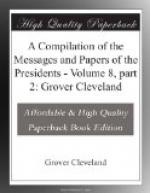Second. Because by its original definition in the grant to De Monts it excludes the whole disputed territory on the one side; and
Third. Because in its practical sense, as a real settlement, it is wholly to the east of the meridian of the St. Croix, and this excludes the whole of the disputed territory on the other.
The portion of the territory granted to the Duke of York, and which is now the subject of dispute, therefore can not be claimed as a part of Acadie, as it never fell within its limits either by charter or by occupation.
Note VIII.
[Extract from the award of the King of the Netherlands.]
Considering that in 1763, 1765, 1773, and 1782 it was established that Nova Scotia should be bounded at the north as far as the western extremity of the Bay des Chaleurs by the southern boundary of the Province of Quebec; that this delimitation is again found with respect to the Province of Quebec in the commission of the Governor-General of Quebec of 1786, wherein the language of the proclamation of 1763 and of the Quebec act of 1774 has been used, as also in the commissions of 1786 and others of subsequent dates of the governors of New Brunswick, with respect to the last-mentioned Province, as well as in a great number of maps anterior and posterior to the treaty of 1783; and that the first article of the said treaty specifies by name the States whose independence is acknowledged; but that this mention does not imply (implique) the entire coincidence of the boundaries between the two powers, as settled by the following article, with the ancient delimitation of the British Provinces, whose preservation is not mentioned in the treaty of 1783, and which, owing to its continual changes and the uncertainty which continued to exist respecting it, created from time to time differences between the provincial authorities.
Note IX.
[Article IV of the convention of 1827.]
The map called Mitchell’s map, by which the framers of the treaty of 1783 are acknowledged to have regulated their joint and official proceedings, and the Map A, which has been agreed on by the contracting parties as a delineation of the water courses, and of the boundary lines in reference to the said water courses, as contended for by each party, respectively, and which has accordingly been signed by the above-named plenipotentiaries at the same time with this convention, shall be annexed to the statements of the contracting parties and be the only maps that shall be considered as evidence mutually acknowledged by the contracting parties of the topography of the country.




